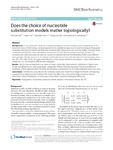Mostrar o rexistro simple do ítem
Does the choice of nucleotide substitution models matter topologically?
| dc.contributor.author | Hoff, Michael | |
| dc.contributor.author | Orf, Stefan | |
| dc.contributor.author | Riehm, Benedikt | |
| dc.contributor.author | Darriba, Diego | |
| dc.contributor.author | Stamatakis, Alexandros | |
| dc.date.accessioned | 2018-08-29T08:35:33Z | |
| dc.date.available | 2018-08-29T08:35:33Z | |
| dc.date.issued | 2016-03-24 | |
| dc.identifier.citation | Hoff, M., Orf, S., Riehm, B., Darriba, D., & Stamatakis, A. (2016). Does the choice of nucleotide substitution models matter topologically?. BMC bioinformatics, 17(1), 143. | es_ES |
| dc.identifier.issn | 1471-2105 | |
| dc.identifier.uri | http://hdl.handle.net/2183/20981 | |
| dc.description.abstract | [Abstract] Background: In the context of a master level programming practical at the computer science department of the Karlsruhe Institute of Technology, we developed and make available an open-source code for testing all 203 possible nucleotide substitution models in the Maximum Likelihood (ML) setting under the common Akaike, corrected Akaike, and Bayesian information criteria. We address the question if model selection matters topologically, that is, if conducting ML inferences under the optimal, instead of a standard General Time Reversible model, yields different tree topologies. We also assess, to which degree models selected and trees inferred under the three standard criteria (AIC, AICc, BIC) differ. Finally, we assess if the definition of the sample size (#sites versus #sites × #taxa) yields different models and, as a consequence, different tree topologies. Results: We find that, all three factors (by order of impact: nucleotide model selection, information criterion used, sample size definition) can yield topologically substantially different final tree topologies (topological difference exceeding 10 %) for approximately 5 % of the tree inferences conducted on the 39 empirical datasets used in our study. Conclusions: We find that, using the best-fit nucleotide substitution model may change the final ML tree topology compared to an inference under a default GTR model. The effect is less pronounced when comparing distinct information criteria. Nonetheless, in some cases we did obtain substantial topological differences. | es_ES |
| dc.language.iso | eng | es_ES |
| dc.publisher | BioMed Central Ltd. | es_ES |
| dc.relation.uri | https://doi.org/10.1186/s12859-016-0985-x | es_ES |
| dc.rights | Atribución 3.0 España | es_ES |
| dc.rights.uri | http://creativecommons.org/licenses/by/3.0/es/ | * |
| dc.subject | Phylogenetics | es_ES |
| dc.subject | Nucleotide substitution | es_ES |
| dc.subject | Model selection | es_ES |
| dc.subject | Information criterion | es_ES |
| dc.subject | BIC | es_ES |
| dc.subject | AIC | es_ES |
| dc.title | Does the choice of nucleotide substitution models matter topologically? | es_ES |
| dc.type | info:eu-repo/semantics/article | es_ES |
| dc.rights.access | info:eu-repo/semantics/openAccess | es_ES |
| UDC.journalTitle | BMC Bioinformatics | es_ES |
| UDC.volume | 17 | es_ES |
| UDC.issue | 1 | es_ES |
| UDC.startPage | 143 | es_ES |
| dc.identifier.doi | 10.1186/s12859-016-0985-x |
Ficheiros no ítem
Este ítem aparece na(s) seguinte(s) colección(s)
-
GI-GAC - Artigos [193]






